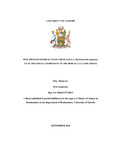| dc.description.abstract | Dagaa is a small pelagic fish found in Lake Victoria. It is mainly used as a nutrient source in the animal feed industry as well as for human consumption among the poor and the middle class. Fish protein hydrolysate as a source of nutrient in culture media has been explored in several fish species such as Silver Carp, Yellow Tuna, Yellow Stripe Trevally, Herring and Mackerel. Dagaa could also be an excellent candidate for culture media since it is rich in proteins, lipids and minerals. This would also add value to the underutilized fish species and minimize post-harvest losses of up to 50% during rainy seasons. In the current study, Dagaa as a source of nitrogen in culture media was explored by first preparing the Dagaa Protein Hydrolysate (DPH) using Alcalase enzyme. Proximate analysis for protein, lipid, moisture /dry weight and ash contents of DPH was performed and compared with that of Dagaa, Dagaa Fish Hydrolysate (DFH), Standard media Luria Bertani (LB) and Sabouraud’s Dextrose Broth (SDB). Mineral analysis was also performed on all these samples. The potential of DPH as a nitrogen source in microbial growth media was investigated using; Escherichia coli, Pseudomonas aeruginosa, Bacillus subtilis and Rhodobacter capsulatus for bacterial growth studies while Metarhizium anisopliae and Beauveria bassiana were used for fungal growth. Potential of DPH to sustain production of commercial valued enzyme amylase was also investigated with R. capsulatus and B. subtilis in DPH-Starch media. This was done using Dinitrosalicylic (DNS) acid assay. M. anisopliae was analyzed for sporulation (conidia production) rate in DPH-Dextrose media. Proximate and mineral analysis indicated that there was significant difference (p<0.05) in the nutritional and mineral profiles of DPH and the two standard media (LB and SD). The protein content of DPH was higher than that of LB and SDB while the mineral content of DPH was lower than that of LB but slightly higher than that of SDB. LB had more Sodium content than DPH. Investigation of the potential of DPH as a nitrogen source in media indicated that in all microorganisms used in this study, there was no significant difference (p˃0.05) in DPH-FM and DPH-Dextrose as compared to standard media in the growth of microorganisms. The potential for DPH-Starch to sustain production of commercial valued amylase indicated that there was significant difference (p<0.05) in the sustenance of amylase production in formulated DPH-Starch and standard media by R. capsulatus and B. subtilis. DPH-Starch media gave better production of amylase enzyme in both microbes than the standard media. There was no significant difference (p˃0.05) in the sporulation rates of M. anisopliae in DPH-Dextrose and the standard media. Hence DPH formulated media can be substituted as a potential culture media for microbial growth. The cost of formulation is low and provides an alternative means of value addition to Dagaa | en_US |



